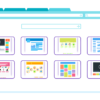In this guide, we will walk you through the process of displaying MySQL database posts in a custom pattern. This will include fetching posts from your MySQL database, displaying them in a unique layout, fetching and displaying featured images and categories, and tracking and displaying post views.
Step 1: Fetching MySQL Database Posts
First, you need to connect to your MySQL database and fetch the posts. Here’s how you can do it:
<?php
$servername = "localhost";
$username = "database_username";
$password = "database_password";
$dbname = "database_name";
// Create connection
$conn = new mysqli($servername, $username, $password, $dbname);
// Check connection
if ($conn->connect_error) {
die("Connection failed: " . $conn->connect_error);
}
// Fetch the posts
$sql = "SELECT * FROM posts LIMIT 50"; // Adjust your query as needed
$result = $conn->query($sql);
$posts = array();
if ($result->num_rows > 0) {
while ($row = $result->fetch_assoc()) {
$posts[] = $row;
}
} else {
echo "No posts found.";
}
$conn->close();
?>
Step 2: Displaying Posts in a Custom Layout
Next, we display the posts in a custom layout. The goal is to show 4 medium-sized posts, 4 small-sized posts, and 1 large post, repeating this pattern:
<?php if (!empty($posts)): ?>
<?php $total_posts = count($posts); ?>
<?php for ($i = 0; $i < $total_posts; $i += 9): ?>
<div class="row">
<!-- Medium posts -->
<?php for ($j = 0; $j < 4; $j++): ?>
<?php if (isset($posts[$i + $j])): ?>
<div class="medium-post">
<a href="<?php echo $posts[$i + $j]['link']; ?>">
<img src="<?php echo $posts[$i + $j]['medium']; ?>" alt="<?php echo $posts[$i + $j]['title']; ?>">
<h2><?php echo $posts[$i + $j]['title']; ?></h2>
</a>
<p><?php echo $posts[$i + $j]['excerpt']; ?></p>
<p>Categories: <?php echo $posts[$i + $j]['category_links']; ?></p>
<p>Views: <?php echo $posts[$i + $j]['views']; ?></p>
</div>
<?php endif; ?>
<?php endfor; ?>
<!-- Small posts -->
<?php for ($j = 4; $j < 8; $j++): ?>
<?php if (isset($posts[$i + $j])): ?>
<div class="small-post">
<a href="<?php echo $posts[$i + $j]['link']; ?>">
<img src="<?php echo $posts[$i + $j]['thumbnail']; ?>" alt="<?php echo $posts[$i + $j]['title']; ?>">
<h2><?php echo $posts[$i + $j]['title']; ?></h2></a>
<p><?php echo $posts[$i + $j]['excerpt']; ?></p>
<p>Categories: <?php echo $posts[$i + $j]['category_links']; ?></p>
<p>Views: <?php echo $posts[$i + $j]['views']; ?></p>
</div>
<?php endif; ?>
<?php endfor; ?>
<!-- Large post -->
<?php if (isset($posts[$i + 8])): ?>
<div class="large-post">
<a href="<?php echo $posts[$i + 8]['link']; ?>">
<img src="<?php echo $posts[$i + 8]['large']; ?>" alt="<?php echo $posts[$i + 8]['title']; ?>">
<h2><?php echo $posts[$i + 8]['title']; ?></h2>
</a>
<p><?php echo $posts[$i + 8]['excerpt']; ?></p>
<p>Categories: <?php echo $posts[$i + 8]['category_links']; ?></p>
<p>Views: <?php echo $posts[$i + 8]['views']; ?></p>
</div>
<?php endif; ?>
</div>
<?php endfor; ?>
<?php endif; ?>
Step 3: Fetching and Displaying Featured Images and Categories
Ensure your $posts array includes the necessary data for each post, such as title, excerpt, link, and image URLs:
<?php
// Example structure for each post
$posts[] = array(
'title' => $row['title'],
'excerpt' => $row['excerpt'],
'link' => $row['link'],
'thumbnail' => $row['thumbnail'],
'medium' => $row['medium'],
'large' => $row['large'],
'category_links' => $row['category_links'],
'views' => $row['views']
);
?>
Step 4: Tracking and Displaying Post Views
Create custom functions to set and get the view count:
<?php
function set_post_views($postID) {
global $conn;
$sql = "UPDATE posts SET views = views + 1 WHERE id = $postID";
$conn->query($sql);
}
function get_post_views($postID) {
global $conn;
$sql = "SELECT views FROM posts WHERE id = $postID";
$result = $conn->query($sql);
$row = $result->fetch_assoc();
return $row['views'] . ' Views';
}
?>
Increment the view count when a post is viewed:
<?php
if (isset($_GET['post_id'])) {
$postID = $_GET['post_id'];
set_post_views($postID);
}
?>
By following these steps, you can display MySQL database posts in a custom layout with featured images, categories, and view counts. This approach allows you to provide a unique and engaging user experience on your website.
Feel free to adjust and customise the code snippets to better fit your theme and design requirements.














Leave a Reply